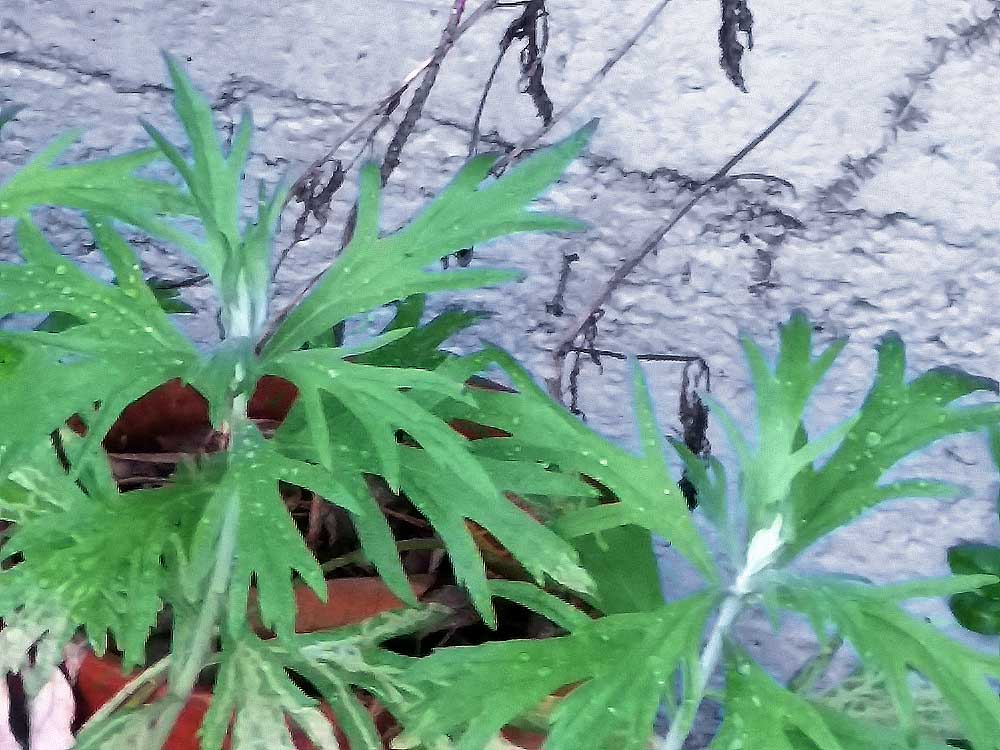
Artemisia douglasiana, Mugwort.
This California native mugwort, here growing in a container, is happy after this year’s wet winter. I acquired a couple of specimens last summer, and they looked pretty rangy during those dry months. Like many native plants, mugwort is pretty resilient, tolerating shade and aridity up to a point, but in nature it favors moist locations.
It’s an underappreciated perennial plant for the garden. While top leaves are whole, lower leaves are lobed in a sharply jagged cleft pattern. The evenly-spaced leaves are dark green above and silvery (and a little wooly) below. The plant is aromatic, especially when the leaves are crushed. It attracts butterflies and birds, and is said to be deer resistant. Stems grow erect from runners (which are not too difficult to control); some sources say they get to six feet tall, but I have never seem this plant above about three or four feet. Flowers (summer to fall) are insignificant.
Artemsias are in the Asteraceae (sunflower) family. Artemisia douglasiana is sometimes classed as Artemesia vulgaris var. douglasiana, but it is much more bitter and strongly flavored than the European mugwort (Artemesia vulgaris) referenced in many herbals. (There is also a Korean variety, which is closer to the European than to this native California mugwort.)
Also known as Dream Plant, the leaves of mugwort contain some of the same substances (notably thujone and cineole) as those of another Atemisia, wormwood (Artemisia absinthium). When smoked or drunk as a tea, they are said to produce vivid dreams, and to ward off the spirits of the dead. Native Californians sometimes wore mugwort necklaces for protection against such spirits. In the European tradition it was held that pillows stuffed with mugwort could reveal one’s future in dreams. One herbalist calls mugwort “ the star of any dream pillow.” A reference more to my taste is “The Natural History of Orange County, California and Nearby Places,” which cites several print sources.
Many health claims are made for mugwort, perhaps foremost that it is an antidote to poison oak skin reactions (which is convenient since the plants often grow together). If applied soon after exposure, the crush leaves are said to lessen the effects of the poison oak. In any case, they are moisturizing to the skin.
Among the many other health claims made for mugwort are relief of joint pain and headaches, calming of spasms and other nervous maladies, improvement of digestion and relief from stomach ache, prevention of reflux, processing of rancid fats, and regulation of menstruation. Before going crazy with mugwort self-medication, it might be good to check out a scholarly article published in the National Library of Medicine, which seems to indicate that mugwort extracts are cytotoxic against both normal and cancerous human cells. The nine authors conclude that “until further is known about the safety of this medicine, caution should be taken when consuming extracts of California mugwort, whether as a tincture or as a tea.” Dosage is likely an important factor.
On the other hand, mugwort has an extremely long history of human use. Julie James of the Green Wisdom Herbal Education Garden in Longbeach has a good video on growing mugwort and using it as an herb. Another video that might be of interest is a recording of a naturalist talk by naturalist Dennis Dowling.
I haven’t used this plant medicinally, although I have used its cousin, Artemisia absinthium, as an antidote to amoebas (acquired in travels in Latin America and Asia), and as a bittering agent in cocktail bitters. Each of the five artemisias in my garden (douglasiana, absinthium, pycnocephala, dracunculus, and californica) is quite distinct in appearance. This one has grown on me just as a garden plant. I am keeping it by one of the garden faucets, where it regularly gets a bit of spillage, near my collection of mints.
